-
Engine3.5L V6
-
Power268 HP / 248 LB-FT
-
Transmission6-Speed Auto
-
DrivetrainFront-Wheel Drive
-
Curb Weight3,420 LBS
-
Seating2+3
-
Cargo15.4 CU-FT
-
MPG21 City / 30 HWY
Patron-Saint Of Mid-Sizers Gets Massaged
Toyota has manufactured and sold 15 million Camry models across 100 countries since it debuted way back in 1983. It's a number that's nearly unfathomable. If all of those polite four-doors were still roaming the earth, there'd be one for every man, woman and child in Virginia, Maryland and Washington D.C. combined, and you'd still have a almost a million vehicles left over. Even more eye-widening is Toyota's claim that of the Camry models built and sold over the last 15 years, 90 percent are still happily enduring a daily commute on nearly every corner of the planet. By sheer volume and longevity, the Camry is nothing short of an engineering and manufacturing wonder.
Almost by default, the Camry has grown to become the vehicle by which all other mid-sized creations must measure themselves, and over the past two years, Ford, Hyundai, Kia and Volkswagen have unveiled products designed specifically to lure buyers from the Toyota model's swollen ranks. In response, Toyota City has turned out the seventh-generation Camry – a model that's been altered with blink-and-you'll-miss-it delicacy. But as millions of current Camry owners will tell you, that may not be a bad thing.
CLICK HERE to read AutoblogGreen's First Drive review of the 2012 Toyota Camry Hybrid.
Catch the 2012 Toyota Camry from the corner of your eye and chances are good you'll have a hard time telling it from its predecessor. The latest generation carries itself with dimensions identical to the 2011 model. Total length, wheelbase, width and height are all carried-over dimensions, resulting in a familiar profile. Even so, the company's engineers and designers have cloaked the sedan in entirely new sheetmetal from stem to stern. A completely new nose incorporates a refreshed headlight design with an integrated chrome grille. The assembly splays from fender to fender with the goal of giving the vehicle the impression of greater width without actually stretching the model's track.
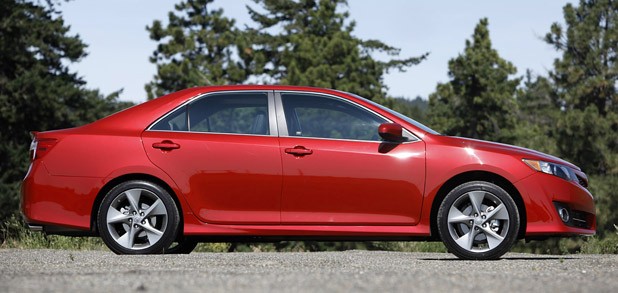
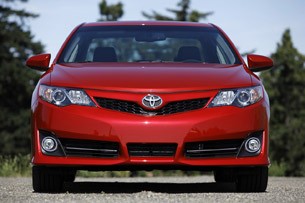
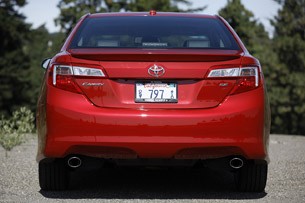
A new front bumper cover with a jutting chin and expansive lower air intake is framed by chrome foglight recesses on L, LE and XLE models, though our SE tester came equipped with a decidedly more stylish front fascia. With three front air inlets, subtle chrome accenting, a honeycomb grille insert and a set of faux canards, the Camry SE manages to be more engaging than forgettable – certainly a step in the right direction for the model. Above all else, Toyota has worked to make the Camry as slippery as possible, and the company has brought all of its considerable aerodynamic knowledge to bear on the sedan. As such, all trims are now built with squared-off aero corners at the front and rear in a fashion that's similar to what we've seen on the Prius line.
The 2012 Camry's sides are contoured with an angled character line, and door handles are tucked just below the detail. Toyota desperately wants us to believe that the new crease helps give the vehicle a wedge-like shape, but the truth is that from a profile view, the 2012 Camry remains very similar to its sixth-generation counterpart. As part of the overall aerodynamic package, the side-view mirrors feature a small fin designed to create air vortices as the vehicle travels at speed. According to Toyota, those vortices provide a protective buffer around the car to help the vehicle slip through the air. The company says the tech was gleaned from its Formula One efforts.
Wheel options start with a 16-inch steel roller with a plastic cover on the fleet-oriented L trim, though 17-inch alloys can be had on LE, XLE and SE vehicles. Our V6 tester came packing the largest option of the bunch – an 18-inch aluminum alloy wheel with a twisted-spoke design.
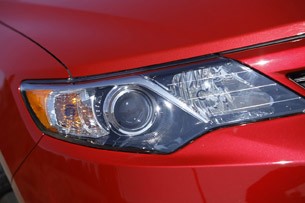
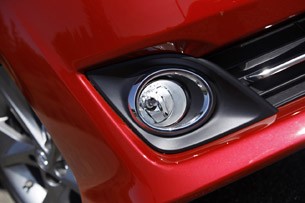
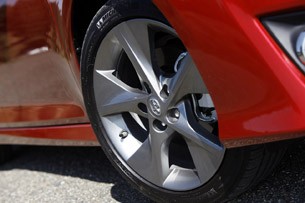
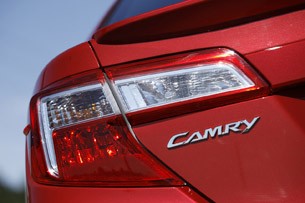
The rear of the sedan incorporates new taillights that back away from the chrome-and-clear heavy design of the 2011 model for a more mature look. The lamps boast an integrated aerodynamic fin, just like the side-view mirrors, and L, LE and XLE vehicles wear a chrome accent across the span of the trunk. Meanwhile, SE models are equipped with a monochrome accent and slightly more aggressive dual chrome exhaust tips as well as a trunk-lid lip spoiler.
Despite the fact that the exterior shell hasn't grown in any direction, Toyota worked to give the cabin a more open appearance thanks to adjustments to the headliner, A- and B-pillar caps, center console and door control panels. Even the shape of the front seatbacks has been reworked for a little more knee room. Unfortunately, the changes are so slight that we would have been hard-pressed to notice without prior knowledge. There's no missing the vehicle's new dash, however.
The 2011 model's bland swaths of plastic have been replaced with a nicely sculpted upper dash hewn from soft-touch plastic and stitched with a line of contrasting thread for a little color. Toyota has differentiated interior accent work by trim to some extent, with L and LE models receiving aluminum-look plastics while SE guise is saddled with a satin version of the same gear. Top-of-the-line XLE trims are still laden with some of the worst-looking simulated wood we've ever seen, however. The center stack stretches from windshield to shift console with a pair of vents positioned up high and a navigation and entertainment screen nestled just below. The whole kit is trimmed in matte black plastic regardless of interior color choice.
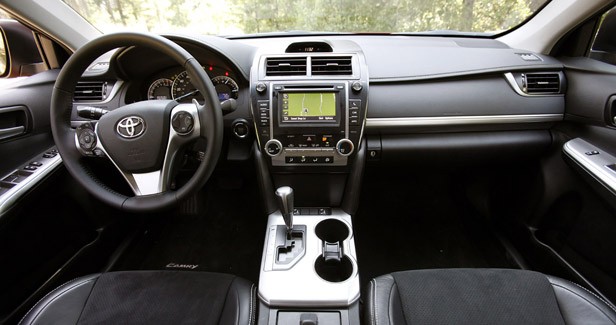
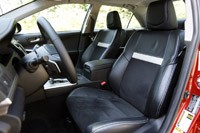
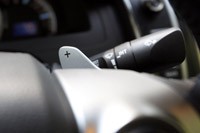
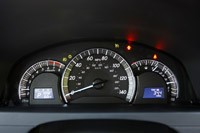
A total of three audio display systems are available depending on trim, starting with a six-speaker AM/FM/CD head with an LCD screen attached to six speakers. Step up a level and the Camry delivers a 6.1-inch touchscreen unit with HD radio, iTunes tagging and voice-recognition navigation. The system also allows for the personalization of various vehicle systems, including exactly which doors unlock at the press of the key fob.
At the top of the heap, a premium navigation system offers up a 7-inch display coupled to 10 JBL GreenEdge speakers. That's two more speakers than the best audio system in the last generation Camry, though JBL has managed to cut the total weight and power consumption of the set to levels well below the gear in the 2011 model. JBL says that the company's GreenEdge speakers suck down 58 percent less energy than before while producing higher-quality sound at the same time.
Though we found the graphics on the screen to be nothing to write home about, the touch interface was certainly quick enough. Unfortunately, we found the screen tilted at such an angle as to be in near constant glare. While the tune and volume knobs are set somewhat high on the dash, the steering-wheel mounted controls are easy to memorize and manipulate, eliminating the need to reach across to the center stack. Toyota has also redesigned the climate control interface with larger dials and buttons. The gear is functional enough, but to our hands, feels exceedingly cheap to the touch.
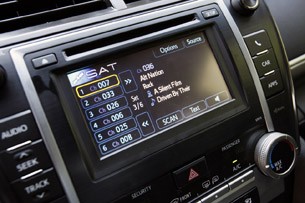
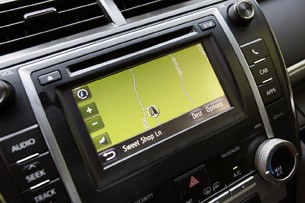
Designers have clad the Camry's seats in multi-tone fabric on L, LE and XLE four-cylinder models. The material feels fine to the touch, but incorporates some fairly strange-looking insert patterns. Fortunately, you don't have to stare at the material while you're driving down the road. Our tester was much less controversial, boasting leather-trimmed buckets with high-quality hide, contrasting stitching and perforated faux suede inserts.
The 2012 Toyota Camry comes with a few familiar drivetrain options, though the company's engineers have pulled a few tricks to increase fuel economy at every level. Every new Camry comes standard with a column-mounted electronic power steering system as well as low-rolling resistance tires. Laudably, total vehicle weight has been trimmed by as much as 150 pounds in four-cylinder configuration.
Speaking of powerplants, base models are equipped with the same 2.5-liter inline four-cylinder engine found in the 2011 model. With 178 horsepower at 6,000 rpm and 170 pound-feet of torque at 4,100 rpm, the engine continues to provide smooth acceleration without undue noises or vibrations. Toyota estimates that the vehicle will be able to return 25 miles per gallon city, 35 mpg highway, or 28 mpg combined. That's a three mpg increase in the city and two mpg bump on the highway and combined over the old vehicle.
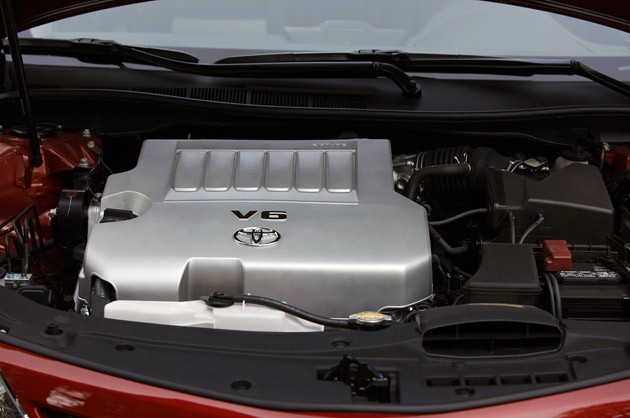
If that's not enough power for you, Toyota will continue to offer the same 3.5-liter V6 engine found in the outgoing model. With 268 horsepower at 6,200 rpm and 248 lb-ft of torque at 4,700 rpm, the engine is expected to deliver 21 mpg city, 30 mpg highway and 25 mpg combined once the Environmental Protection Agency wraps up testing. That's thanks in part to the specification of lower-viscosity 0W-20 oil and a new automatic transmission fluid warmer. Toyota says that getting the fluid to its proper temperature sooner rather than later helps increase power transfer efficiency, though that's not the only change in the gearbox department.
For 2012, the Camry comes equipped with an all-new six-speed automatic transmission, as well as a taller final drive ratio of 3.634 in four-cylinder models and 3.458 on V6 vehicles for improved fuel economy. In addition, the gearbox features flexible logic for torque converter lock-up that can allow the converter to provide some slip to no slip at all, depending on the situation. The driver can manipulate gear selection via a bump shifter on the console or, on SE models, by wheel-mounted paddle shifters. Check out the Short Cut below for a look at the shifters in action.
Toyota engineers have also worked to increase the vehicle's structural rigidity through additional high-strength and ultra-high-strength steel in the A- and B-pillars. The material allowed engineers to cut some weight while beefing up the chassis stiffness. In addition, a total of 56 new welds were spread throughout the chassis for greater rigidity – specifically in the rear of the platform. Toyota also redesigned the front coil springs with an inverse-wound design. The company says the new parts provide greater straight-line stability, and the shocks, roll bar and electronic power steering have all been tweaked to some degree as well. Our SE model also benefited from trim-exclusive lightweight steering knuckles and lower A-arms. A solid roll bar and slightly stiffer springs are also incorporated into the SE trim.
These changes are enough to be perceptible on the road, though the SE still leans more toward the softly sprung end of the suspension spectrum. No one's saying this is ever going to be a sport sedan, but the Camry SE is fairly confident without too much flop or push. In standard driving circumstances, most owners will enjoy a comfortable ride that fields potholes and breaks in the pavement without transferring jolts to the cabin. The new electronic power steering takes some getting used to, as initial turn-in is overly soft and a little vague. Spin the wheel past 10 degrees or so, however, and the system delivers decidedly firmer feedback. We would prefer a more linear feel, but doubt most buyers will care.
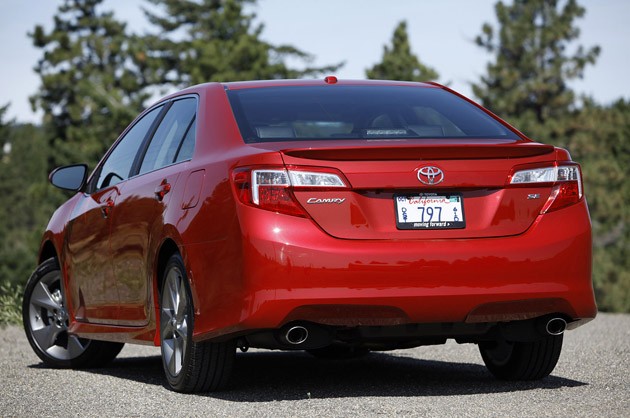
As with the last generation, the 268-horsepower from the 3.5-liter V6 is enough to widen eyes. It's just hard to imagine a Camry picking up its skirt and hustling the way this one does – maybe there's some justification for the four-door's presence on the NASCAR circuit after all. Despite the fact that all the power heads straight to the front wheels, torque steer is minimal, if present at all. Simply romp on the throttle and giggle as you trounce the Fox Body at the stoplight next to you. Seriously.
The new six-speed automatic transmission performs its duties admirably. Shifts are quick enough for family sedan duty and perfectly smooth – just what you want out of a gearbox designed to increase fuel economy and coddle in equal parts. While you can technically click through the gears of your own accord, the delay between your inputs and actual gear selection is too large to be effective. Again, this is a family hauler, not a track machine.
In the end, the seventh generation sedan remains all Camry, through and through. There are absolutely no surprises here, and that simple fact will likely be enough to keep the model ahead of invading hordes, especially as Toyota fully expects half of 2012 Camry buyers to be former owners of the model. Given the number of Camrys still on the road right now, that nearly guarantees it will hold onto its crown as the best-selling car in the United States.
Toyota has manufactured and sold 15 million Camry models across 100 countries since it debuted way back in 1983. It's a number that's nearly unfathomable. If all of those polite four-doors were still roaming the earth, there'd be one for every man, woman and child in Virginia, Maryland and Washington D.C. combined, and you'd still have a almost a million vehicles left over. Even more eye-widening is Toyota's claim that of the Camry models built and sold over the last 15 years, 90 percent are still happily enduring a daily commute on nearly every corner of the planet. By sheer volume and longevity, the Camry is nothing short of an engineering and manufacturing wonder.
Almost by default, the Camry has grown to become the vehicle by which all other mid-sized creations must measure themselves, and over the past two years, Ford, Hyundai, Kia and Volkswagen have unveiled products designed specifically to lure buyers from the Toyota model's swollen ranks. In response, Toyota City has turned out the seventh-generation Camry – a model that's been altered with blink-and-you'll-miss-it delicacy. But as millions of current Camry owners will tell you, that may not be a bad thing.
CLICK HERE to read AutoblogGreen's First Drive review of the 2012 Toyota Camry Hybrid.
Catch the 2012 Toyota Camry from the corner of your eye and chances are good you'll have a hard time telling it from its predecessor. The latest generation carries itself with dimensions identical to the 2011 model. Total length, wheelbase, width and height are all carried-over dimensions, resulting in a familiar profile. Even so, the company's engineers and designers have cloaked the sedan in entirely new sheetmetal from stem to stern. A completely new nose incorporates a refreshed headlight design with an integrated chrome grille. The assembly splays from fender to fender with the goal of giving the vehicle the impression of greater width without actually stretching the model's track.



A new front bumper cover with a jutting chin and expansive lower air intake is framed by chrome foglight recesses on L, LE and XLE models, though our SE tester came equipped with a decidedly more stylish front fascia. With three front air inlets, subtle chrome accenting, a honeycomb grille insert and a set of faux canards, the Camry SE manages to be more engaging than forgettable – certainly a step in the right direction for the model. Above all else, Toyota has worked to make the Camry as slippery as possible, and the company has brought all of its considerable aerodynamic knowledge to bear on the sedan. As such, all trims are now built with squared-off aero corners at the front and rear in a fashion that's similar to what we've seen on the Prius line.
The 2012 Camry's sides are contoured with an angled character line, and door handles are tucked just below the detail. Toyota desperately wants us to believe that the new crease helps give the vehicle a wedge-like shape, but the truth is that from a profile view, the 2012 Camry remains very similar to its sixth-generation counterpart. As part of the overall aerodynamic package, the side-view mirrors feature a small fin designed to create air vortices as the vehicle travels at speed. According to Toyota, those vortices provide a protective buffer around the car to help the vehicle slip through the air. The company says the tech was gleaned from its Formula One efforts.
Wheel options start with a 16-inch steel roller with a plastic cover on the fleet-oriented L trim, though 17-inch alloys can be had on LE, XLE and SE vehicles. Our V6 tester came packing the largest option of the bunch – an 18-inch aluminum alloy wheel with a twisted-spoke design.




The rear of the sedan incorporates new taillights that back away from the chrome-and-clear heavy design of the 2011 model for a more mature look. The lamps boast an integrated aerodynamic fin, just like the side-view mirrors, and L, LE and XLE vehicles wear a chrome accent across the span of the trunk. Meanwhile, SE models are equipped with a monochrome accent and slightly more aggressive dual chrome exhaust tips as well as a trunk-lid lip spoiler.
Despite the fact that the exterior shell hasn't grown in any direction, Toyota worked to give the cabin a more open appearance thanks to adjustments to the headliner, A- and B-pillar caps, center console and door control panels. Even the shape of the front seatbacks has been reworked for a little more knee room. Unfortunately, the changes are so slight that we would have been hard-pressed to notice without prior knowledge. There's no missing the vehicle's new dash, however.
The 2011 model's bland swaths of plastic have been replaced with a nicely sculpted upper dash hewn from soft-touch plastic and stitched with a line of contrasting thread for a little color. Toyota has differentiated interior accent work by trim to some extent, with L and LE models receiving aluminum-look plastics while SE guise is saddled with a satin version of the same gear. Top-of-the-line XLE trims are still laden with some of the worst-looking simulated wood we've ever seen, however. The center stack stretches from windshield to shift console with a pair of vents positioned up high and a navigation and entertainment screen nestled just below. The whole kit is trimmed in matte black plastic regardless of interior color choice.




A total of three audio display systems are available depending on trim, starting with a six-speaker AM/FM/CD head with an LCD screen attached to six speakers. Step up a level and the Camry delivers a 6.1-inch touchscreen unit with HD radio, iTunes tagging and voice-recognition navigation. The system also allows for the personalization of various vehicle systems, including exactly which doors unlock at the press of the key fob.
At the top of the heap, a premium navigation system offers up a 7-inch display coupled to 10 JBL GreenEdge speakers. That's two more speakers than the best audio system in the last generation Camry, though JBL has managed to cut the total weight and power consumption of the set to levels well below the gear in the 2011 model. JBL says that the company's GreenEdge speakers suck down 58 percent less energy than before while producing higher-quality sound at the same time.
Though we found the graphics on the screen to be nothing to write home about, the touch interface was certainly quick enough. Unfortunately, we found the screen tilted at such an angle as to be in near constant glare. While the tune and volume knobs are set somewhat high on the dash, the steering-wheel mounted controls are easy to memorize and manipulate, eliminating the need to reach across to the center stack. Toyota has also redesigned the climate control interface with larger dials and buttons. The gear is functional enough, but to our hands, feels exceedingly cheap to the touch.


Designers have clad the Camry's seats in multi-tone fabric on L, LE and XLE four-cylinder models. The material feels fine to the touch, but incorporates some fairly strange-looking insert patterns. Fortunately, you don't have to stare at the material while you're driving down the road. Our tester was much less controversial, boasting leather-trimmed buckets with high-quality hide, contrasting stitching and perforated faux suede inserts.
The 2012 Toyota Camry comes with a few familiar drivetrain options, though the company's engineers have pulled a few tricks to increase fuel economy at every level. Every new Camry comes standard with a column-mounted electronic power steering system as well as low-rolling resistance tires. Laudably, total vehicle weight has been trimmed by as much as 150 pounds in four-cylinder configuration.
Speaking of powerplants, base models are equipped with the same 2.5-liter inline four-cylinder engine found in the 2011 model. With 178 horsepower at 6,000 rpm and 170 pound-feet of torque at 4,100 rpm, the engine continues to provide smooth acceleration without undue noises or vibrations. Toyota estimates that the vehicle will be able to return 25 miles per gallon city, 35 mpg highway, or 28 mpg combined. That's a three mpg increase in the city and two mpg bump on the highway and combined over the old vehicle.

If that's not enough power for you, Toyota will continue to offer the same 3.5-liter V6 engine found in the outgoing model. With 268 horsepower at 6,200 rpm and 248 lb-ft of torque at 4,700 rpm, the engine is expected to deliver 21 mpg city, 30 mpg highway and 25 mpg combined once the Environmental Protection Agency wraps up testing. That's thanks in part to the specification of lower-viscosity 0W-20 oil and a new automatic transmission fluid warmer. Toyota says that getting the fluid to its proper temperature sooner rather than later helps increase power transfer efficiency, though that's not the only change in the gearbox department.
For 2012, the Camry comes equipped with an all-new six-speed automatic transmission, as well as a taller final drive ratio of 3.634 in four-cylinder models and 3.458 on V6 vehicles for improved fuel economy. In addition, the gearbox features flexible logic for torque converter lock-up that can allow the converter to provide some slip to no slip at all, depending on the situation. The driver can manipulate gear selection via a bump shifter on the console or, on SE models, by wheel-mounted paddle shifters. Check out the Short Cut below for a look at the shifters in action.
Toyota engineers have also worked to increase the vehicle's structural rigidity through additional high-strength and ultra-high-strength steel in the A- and B-pillars. The material allowed engineers to cut some weight while beefing up the chassis stiffness. In addition, a total of 56 new welds were spread throughout the chassis for greater rigidity – specifically in the rear of the platform. Toyota also redesigned the front coil springs with an inverse-wound design. The company says the new parts provide greater straight-line stability, and the shocks, roll bar and electronic power steering have all been tweaked to some degree as well. Our SE model also benefited from trim-exclusive lightweight steering knuckles and lower A-arms. A solid roll bar and slightly stiffer springs are also incorporated into the SE trim.
These changes are enough to be perceptible on the road, though the SE still leans more toward the softly sprung end of the suspension spectrum. No one's saying this is ever going to be a sport sedan, but the Camry SE is fairly confident without too much flop or push. In standard driving circumstances, most owners will enjoy a comfortable ride that fields potholes and breaks in the pavement without transferring jolts to the cabin. The new electronic power steering takes some getting used to, as initial turn-in is overly soft and a little vague. Spin the wheel past 10 degrees or so, however, and the system delivers decidedly firmer feedback. We would prefer a more linear feel, but doubt most buyers will care.

As with the last generation, the 268-horsepower from the 3.5-liter V6 is enough to widen eyes. It's just hard to imagine a Camry picking up its skirt and hustling the way this one does – maybe there's some justification for the four-door's presence on the NASCAR circuit after all. Despite the fact that all the power heads straight to the front wheels, torque steer is minimal, if present at all. Simply romp on the throttle and giggle as you trounce the Fox Body at the stoplight next to you. Seriously.
The new six-speed automatic transmission performs its duties admirably. Shifts are quick enough for family sedan duty and perfectly smooth – just what you want out of a gearbox designed to increase fuel economy and coddle in equal parts. While you can technically click through the gears of your own accord, the delay between your inputs and actual gear selection is too large to be effective. Again, this is a family hauler, not a track machine.
In the end, the seventh generation sedan remains all Camry, through and through. There are absolutely no surprises here, and that simple fact will likely be enough to keep the model ahead of invading hordes, especially as Toyota fully expects half of 2012 Camry buyers to be former owners of the model. Given the number of Camrys still on the road right now, that nearly guarantees it will hold onto its crown as the best-selling car in the United States.










Sign in to post
Please sign in to leave a comment.
Continue